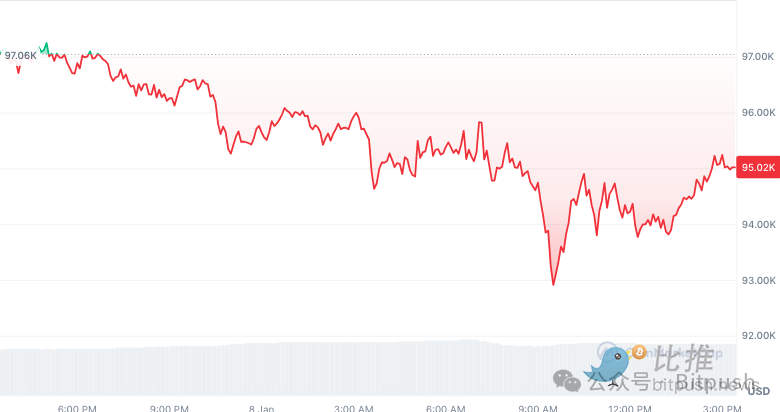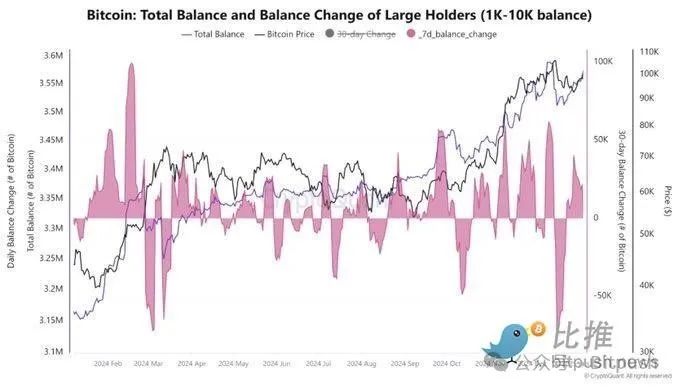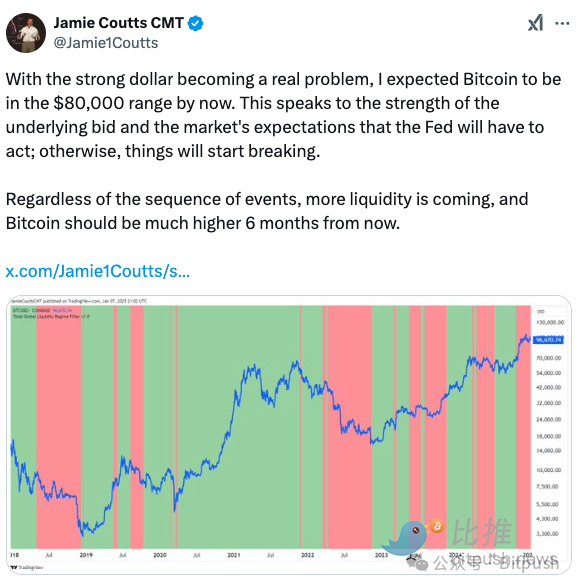The U.S. dollar index (DXY) hit a new high and the cryptocurrency market corrected for the second consecutive day as U.S. Treasury yields rose and investors adjusted their expectations for the Federal Reserve's monetary policy.
CMC data shows that in the past 24 hours, BTC fell to an intraday low of $92,600. As of press time, it rebounded to around $94,400. It was still down 2.1% in the past 24 hours, and Ethereum fell to around $3,330.

This trend is closely related to the strong economic data released by the United States, including a surge in job openings and better-than-expected manufacturing performance. These data further consolidated the view of Federal Reserve Chairman Powell that an aggressive interest rate cut strategy may not be needed this year to effectively control inflation. "Fed mouthpiece" Nick Timiraos pointed out that the minutes of the Federal Reserve meeting released today further showed that officials were generally willing to keep interest rates unchanged at the upcoming meeting at the end of this month. As a result, the market adjusted its expectations for the Fed's future monetary policy, and risk assets fell under pressure.
CoinGlass data showed that two consecutive days of pullbacks caused nearly $1 billion worth of crypto leveraged derivatives positions to be liquidated, mainly long positions betting on an increase.
Macroeconomic and policy expectations dominate market sentiment
The pullback in Bitcoin prices reflects the market’s correction of its previous optimistic expectations for Bitcoin. The previous optimism was mainly based on two assumptions: first, the Federal Reserve will adopt a more relaxed monetary policy, that is, actively cut interest rates; second, if Trump is re-elected as US President, it is expected to bring a clearer regulatory framework to the cryptocurrency industry.
However, current economic data and the Federal Reserve’s statements have caused the market to doubt the extent to which the above two assumptions can be realized.
Philipp Pieper, co-founder of Swarm Markets, pointed out that in the absence of new market narratives, the cryptocurrency market is gradually returning to the logic of traditional financial markets. When interest rates are low, investors tend to increase their allocation to risky assets such as cryptocurrencies and technology stocks in search of higher returns. But at present, as the Trump administration's cryptocurrency policy remains unclear, market sentiment is cautious, and this uncertainty is expected to continue for some time.
10x Research's analysis report also emphasizes the importance of macroeconomic data to Bitcoin prices. The report believes that the Fed's response to US economic data and global liquidity conditions are two key macro factors affecting Bitcoin price trends. In the short term, Bitcoin prices may enter a "banana zone" of violent fluctuations. The "banana zone" vividly describes the turbulent trend of asset prices under the combined effect of macro factors.
BitMEX founder Arthur Hayes also analyzed the impact of US dollar liquidity on Bitcoin prices in his latest blog post. He believes that Bitcoin and cryptocurrency prices generally rise when US dollar liquidity increases.
In the past 30 days, institutions have accumulated more than 34,000 bitcoins
Despite the short-term market adjustment pressure, analysts remain optimistic about the long-term prospects of Bitcoin. CryptoQuant's on-chain data shows that the market's "underlying demand for Bitcoin remains very strong." The agency measures market demand by comparing the number of idle Bitcoins with the new Bitcoin supply from miners. When the reduction in idle Bitcoins far exceeds the new supply, it indicates strong market demand.
CryptoQuant analysts wrote that around December 21, 2024, institutional investors sold about 79,000 bitcoins in a week, causing a 15% correction in the market. However, large institutions then took advantage of the market consolidation period and continued to buy below $95,000 using the time-weighted average price (TWAP) strategy. In the past 30 days, institutional investors have accumulated more than 34,000 bitcoins, providing buying support for the recent rebound in Bitcoin.

Despite periods of correction in institutional portfolios, the trend of on-chain Bitcoin accumulation has remained evident since June 2023. This suggests that institutional interest in Bitcoin remains high even as retail demand is at a five-year low.
CryptoQuant analysis also shows that Bitcoin’s pullback has caused traders’ unrealized profits to shrink significantly, which is normal after a sharp rise. Currently, traders’ realized prices are around $88,000 (usually a price support in a bull market).
Historical data shows that Bitcoin has experienced a pullback in January after the past two U.S. presidential elections, with a drop of 36% in both January 2017 and January 2021.

Jamie Coutts, chief crypto analyst at Real Vision, commented on the X platform: "As the strengthening of the US dollar becomes a real problem, I expected Bitcoin to be around $80,000 now, but it didn't fall to this level, which shows the strength of potential buying and the market's expectation that the Fed will have to take action; otherwise, the situation will start to deteriorate. No matter how the event develops, more liquidity is coming, and Bitcoin should be much higher in 6 months."
Overall, Bitcoin's recent pullback is mainly affected by macroeconomic data and changes in the Fed's policy expectations. In the short term, the market may still maintain a volatile pattern. However, the continued accumulation of institutional investors and the strong demand reflected by on-chain data will provide support for the long-term trend.











